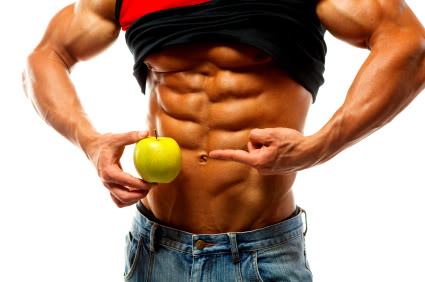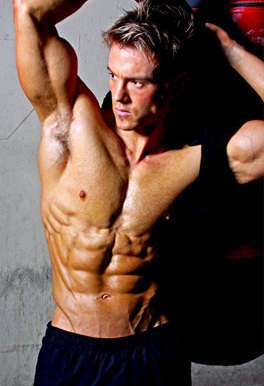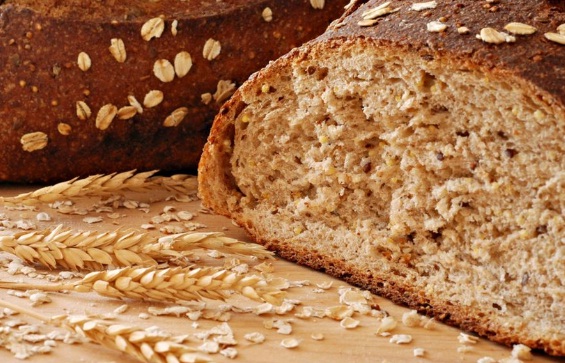Effectively decreasing bodyfat while maintaining muscle mass is more complex than implementing one or two fat-burning strategies. Many bodybuilders simply cut carbs and start taking a fat burner when they go on a program to shed bodyfat. Knowing how to make the most of supplementation, diet and training, however, can dramatically impact the ability to shed bodyfat.

Consider integrating several of these fat-burning strategies into your next ripping-up phase.
1 | Use a thermogenic product
There are many different types of “fat burner” supplements on the market, but perhaps the most popular and effective category is thermogenics. Thermogenics work by boosting the body’s metabolism. That is, you burn more calories during a given activity, even if you’re just sitting on your butt watching Pumping Iron again. Most products achieve this effect by increasing norepinephrine (a neurotransmitter that the nervous system releases; it is basically a form of adrenaline). Synephrine is one supplement that raises norepinephrine. Try doses of five to 20 milligrams (mg), from a standardized Citrus aurantium extract, once or twice daily for a maximum of 40 mg per day.
2 | Take a fat mobilizer
You not only want to burn more calories, but also to make sure that many of those calories come from stored bodyfat. Certain supplements help to encourage fat to leave their hideaways (fat cells) and get burned for fuel. Forskolin is derived from the mintlike herb Coleus forskohlii. It activates fat breakdown from within fat cells. Supplements that deliver 20-50 mg of actual forskolin, taken two or three times per day, might do the trick. Caffeine also works well to get exercising muscles to use more fat. Take 200-400 mg an hour or two before workouts.
3 | Use an appetite suppressant
 To shed more bodyfat, you have to eat less there is no way around it. The good news is that there are supplements that can help blunt hunger pangs and keep you from binging. Simmondsin is a jojoba extract that can dramatically blunt appetite by stimulating the production of cholecystokinin, a hormone that increases feelings of satiety.
To shed more bodyfat, you have to eat less there is no way around it. The good news is that there are supplements that can help blunt hunger pangs and keep you from binging. Simmondsin is a jojoba extract that can dramatically blunt appetite by stimulating the production of cholecystokinin, a hormone that increases feelings of satiety.
Try doses of 100-500 mg on an empty stomach, one to three times per day.
4 | Try a thyroid enhancer
Seven-keto is a natural metabolite of dehydroepiandrosterone (DHEA), the hormone that forms testosterone. By increasing the production of thyroid hormones, 7-keto increases metabolic rate. Try 100-200 mg of 7-keto DHEA per day in two or three divided doses.
5 | Take healthy fats
Healthy fats are beneficial to dieters, whether the fats come in supplement or whole-food form. Supplements include essential fatty acids from fish oil or flaxseed oil. Take two to four grams (g) of fish oil or a tablespoon or two of flaxseed oil daily.
For whole-food sources, rely on avocados; nuts and seeds; fatty fish, such as salmon; and healthy oils, such as olive and canola.
6 | Eat multiple meals a day
Each time you consume a meal, your metabolic rate rises as your body processes the food. The more meals you eat daily, the higher your total metabolic rate. This method of eating also provides your body with an influx of energy and nutrients, helping to keep your body chemistry stabilized until the next meal so that it doesn’t tear down muscle mass to produce needed nutrients. Strive for six or more meals a day spread two or three hours apart.
7 | Consume fewer calories at each meal
If you’re eating more meals, you must reduce the number of calories consumed at each one to prevent taking in more calories than before you started your diet. Strive for fewer total calories than you need for maintenance to encourage your body to tap into bodyfat stores for energy. See #3 on taking simmondsin to blunt your appetite.
8 | Increase vegetable and fruit consumption
Fruits and vegetables are high in fiber and in water. In addition, each fruit and vegetable provides a unique nutrient profile. Vegetables are particularly good for dieters because of their very low calorie counts. Fruits are relatively low in calories, but generally contain more carbs. While dieting, limit fruit consumption to a piece or two a day. Steamed vegetables, such as broccoli, cauliflower and spinach, are essentially “free foods” for dieters, and they can be eaten in large quantities throughout the day.
You don’t need to count them against your total carb count.

9 | Reduce calories throughout the day
One of the best strategies for ramping up bodyfat burning is to reduce the number of calories consumed at each meal. For example, on a 2,400-calories-per-day diet, consider this caloric strategy for successive meals, beginning with breakfast: 600, 500, 400, 300, 400, 200. (The bump up in calories for the fifth meal is to allow a little more food at dinner.)
10 | Keep carbs moderate
Some bodybuilders virtually eliminate carbs from their diets. That may be a good idea a few days before a bodybuilding contest, but it’s rarely a good idea for long-term bodyfat reduction. A good rule of thumb is to eat I g of carbs for every pound of bodyweight on your lowest carb days. Most bodybuilders, even smaller ones, can consume up to 200 g of carbs a day and still shed bodyfat.
11 | Reduce carbs throughout the day
One of the best ways for dieters to cut calories is to consume fewer total carbs. You can cut calories per meal by cutting mostly carbs (as well as some saturated fats). Consider this strategy for consuming 200 g of carbs per day: take in 80, 40, 40, 40, 0 and 0 g at successive daily meals beginning with breakfast. Assuming that you train in the afternoon, take the last 40 g of carbs postworkout (see #14). Your dinner and late-night snack should not include any carbs, as those are the times of day when your body is most likely to store them as bodyfat.
12 | Cut out fast-digesting carbs at most times of day
Fast-digesting carbs, or sugars, are poor choices for dieting bodybuilders. Sugars are quickly absorbed, emptying from your bloodstream relatively quickly, and either burned as energy or stored as bodyfat. As a consequence, you feel depleted and begin to crave more carbs, making dieting a challenge. The best time to consume fast-digesting carbs is postworkout, when your body can take advantage of the insulin spike for muscle growth.
13 | Rely on slow-burning carbs at most times of day
Instead of taking in carb calories in the form of sugar, rely on slow-burning complex carbs. These will stay with you longer, helping to moderate blood sugar levels and preventing a feeling of depletion and the accompanying craving for carbs.
Good sources of complex carbs include brown rice, yams, oatmeal, and whole-grain breads and pastas.

14 | Consume fast-digesting carbs after training
The best time to consume the minimal amount of sugar you do eat is right after you train. Simple carbs help replenish glycogen stores in muscles, aiding recovery and keeping up your strength while you’re in a calorie deficit. Posttraining, when you’re not in a cutting phase, you might take in up to 80 g of simple carbs with approximately 40 g of whey protein; while dieting, consume about 40 g of sugar with about 40 g of whey protein.
15 | Take in plenty of lean protein
One of the best ways to cut calories is to reduce the amount you get from protein foods (without reducing the total number of grams of protein you’re consuming). To do this, switch to leaner forms of protein. Good choices include egg whites; zero- or low-carb whey protein powders; lean meats, such as chicken and turkey breast; and whitefish. At this time, you can take in more protein than during other phases of a bodybuilding diet. Eat at least 1 g of protein per pound of bodyweight per day and as much as 1.5 g of protein per pound (200-300 g of protein for a 200-pound bodybuilder).
16 | Drink plenty of water
 As it promotes health, drinking a lot of water is excellent for everyone, but it’s particularly crucial for dieting bodybuilders. High-protein diets are dehydrating (as are training and life in general). Bodybuilders have a greater need for fluids. The best option is water, which not only provides fluids with no calories, but also contains important minerals. Dieting bodybuilders should drink at least a gallon of water a day, in addition to other liquids they may consume.
As it promotes health, drinking a lot of water is excellent for everyone, but it’s particularly crucial for dieting bodybuilders. High-protein diets are dehydrating (as are training and life in general). Bodybuilders have a greater need for fluids. The best option is water, which not only provides fluids with no calories, but also contains important minerals. Dieting bodybuilders should drink at least a gallon of water a day, in addition to other liquids they may consume.
17 | Eat fiber
As with water, fiber is crucial for health and for dieting bodybuilders. Fiber provides several benefits. It helps provide satiety, a sense of fullness when you eat. It helps you more effectively digest protein and improves the functioning of your digestive system overall. It also helps block the absorption of some calories. Healthy bodybuilders should consume at least 30 g of fiber a day. On a diet, you might take it up to 40 g per day. Increase fiber consumption slowly to prevent digestive upset.
For example, go from about 30 g to 32 or 33 g daily for a week before bumping up the amount again.
18 | Avoid excessively low-calorie diets
How low should you go? The conventional wisdom is to reduce total caloric intake by about 20%. If you eat 3,000 calories per day for bodyweight maintenance, then don’t take your diet below 2,400 calories. When calories are too low, your body breaks down muscle mass, slowing your metabolism.
Exercise Your Options
Burning fat is not just a matter of diet and supplementation. Calories always count, but there are two components to that equation: calories in and calories out. The number of calories you burn can be as important to reducing bodyfat levels as the number of calories you consume.
Consider implementing the following exercise tips to rev up calorie burning to support your diet and supplementation strategies for burning bodyfat.
- Perform cardio in the morning on an empty stomach, or with about 6-10 g of amino acids or 10-20 g of whey protein isolate mixed in water. Your body needs to rely on its stores of bodyfat for energy to help you reduce efficiently.
- Split exercise into two sessions a day, revving up your metabolic rate twice a day. In addition, you are likely to burn more calories in two shorter sessions than in one longer session.
- Perform high reps and more sets. The more exercise you do, the more calories you burn, plain and simple.
- Consider performing whole-body workouts train your entire body three or four times per week, doing one or two exercises per bodypart. You’ll boost your growth-hormone levels, helping to burn bodyfat. It will also increase your metabolism (and it will stay higher for up to two days after such a workout).
Author: Jim Stoppani
References:
http://www.muscleandfitness.com/
http://www.flexonline.com/
COPYRIGHT 2010 Weider Publications
COPYRIGHT 2010 Gale Group










